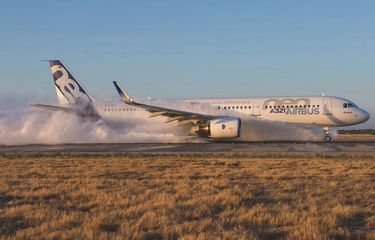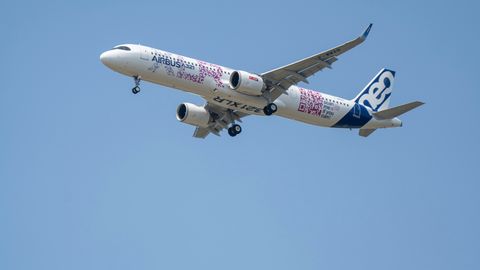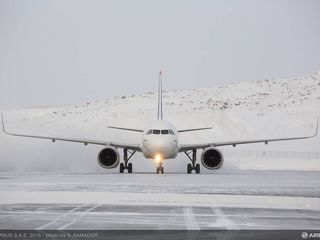Flight test and certification campaign
Before reaching series production, all Airbus aircraft undergo a complex, rigorous flight test and certification campaign. Once approved and certified, the aircraft is cleared for service.
Ensuring airworthiness
To ensure the reliability and maturity of the A350 from the moment it entered into service, Airbus implemented one of the most thorough test programmes ever developed for an aircraft. Lasting just over 14 months – an industry record for the completion time – the A350-900 version’s flight test and certification programme comprised a five-aircraft fleet that performed over 2,600 flight hours in total – with Type Certification subsequently received from the world’s two primary airworthiness authorities: the European Union Aviation Safety Agency for (EASA) Europe, and the U.S. Federal Aviation Administration (FAA).
For Airbus’ A320neo Family, the testing and certification process involved all six versions, with the A319neo, A320neo and A321neo undergoing validation of their airframe, systems and the two powerplant options offered on each aircraft type: CFM International’s LEAP-1A and Pratt & Whitney GTF™ engine.
These campaigns also confirmed the aircraft met their performance targets in terms of fuel burn and range – based on the latest-generation engine choices and large Sharklet wingtip devices.

Ground-based structural tests
In preparation for clearance to perform the milestone first flight, an aircraft undergoes structural static tests that include a re-creation of aerodynamic loads the airplane will experience during its lifetime. The tests typically involve maximum bending of the wings, aileron and spoiler functional testing during wing bend and fuselage pressure tests, along with fatigue tests and the simulation of flight cycles encountered from take-off to landing.
The next steps are certification tests to cover limit loads and ultimate loads in various situations like maximum wing deflection, fuselage loads – all to obtain a full understanding of the aircraft behaviour in extreme conditions.
Fatigue testing examines how the aircraft’s structure responds to loads in conditions that occur in repeated flight cycles – from takeoff, climb-out and cruise, to the descent and landing. The fatigue testing’s purpose is to understand the structural behaviour during the aircraft’s life, along with the inspection methods to be applied in identifying potential fatigue critical areas while the aircraft is in service.
The A350 certification tests covered an equivalent of three times the aircraft’s design lifetime, to include a large safety factor for the fatigue behaviour.
Flight test campaign
An aircraft’s flight test campaign is designed to assess general handling qualities, operational performance, airfield noise levels and systems operation in normal flight modes, along with failure scenarios and extreme conditions – culminating with certification by airworthiness authorities.
Extreme weather trials for the A350 included cold weather testing in Iqaluit, Canada; high altitude evaluations in La Paz, Bolivia and a hot weather campaign in the United Arab Emirates at Al Ain.
In addition, the A350 was the first Airbus aircraft to visit the McKinley Climatic Laboratory in the U.S. state of Florida. At this unique location, the aircraft was subjected to a range of climatic conditions ranging from +40 degrees Celsius to -40 degrees. Celsius in a climate-controlled hangar.
Further certification flight testing for a new aircraft is dedicated to water ingestion trials (when a significant amount of water accumulates on a runway), low speed take-off tests, as well as flutter and rejected take-offs and landings. In addition, wake vortex trials – to measure air turbulence created behind the aircraft at take-off – are included in the steps required for certification.
With the A320neo Family, certification flight testing included validation of the aircraft's new-generation LEAP-1A and Pratt & Whitney GTF™ engines – including their lower fuel burn, environmental footprint, NOx emissions, and engine noise – along with aircraft handling qualities and performance, as well as operation of systems such as the autopilot.
Certification
Certification is a regulatory obligation for all aircraft and their engines, and is issued by the EASA and FAA airworthiness authorities. The Type Certificate – issued to signify the airworthiness of an aircraft’s initial design – is followed by an “Individual Certificate of Airworthiness,” which authorises aircraft to be registered in the country where they operate.
The certification procedure covers the complete development process of a new aircraft and all its subsequent evolutions. It includes various phases:
- Design familiarisation;
- Definition of certification programme (including proposed means of compliance);
- Independent check of compliance demonstration (including test reviews laboratory work; and in-flight validation; and statement of compliance).
All the above is ensured with support from suppliers and operators. The authorities are involved in all phases of the project according to the certification programme.
The airworthiness authorities in their jurisdiction oversee the certification process. Today, the main aircraft certification systems are:
- For the European Union, the EASA (European Union Aviation Safety Agency);
- For the United States, the FAA (Federal Aviation Administration).
The appropriate authority for each Airbus operator validates an aircraft’s operation by releasing the Certificate of Airworthiness according to their legislation.

Global route-proving tours
In addition to the various tests and verifications, new commercial aircraft typically perform global route-proving tours.
With the A350, Airbus brought it to 14 major airports on four different trips, flying approximately 81,700 total nautical miles in 180 flight hours. This also provided future operators the opportunity to see the aircraft in realistic service conditions, and airport operators to familiarise themselves with the ground handling aspects.
Another important aspect of A350 testing was the Early Long Flights (ELF) programme, which went above and beyond certification requirements. For these evaluations, a cabin-equipped flight-test aircraft was operated on simulated commercial services with real “passengers” – composed of Airbus employees – and actual airline flight crews to evaluate cabin systems in typical operating conditions.

















